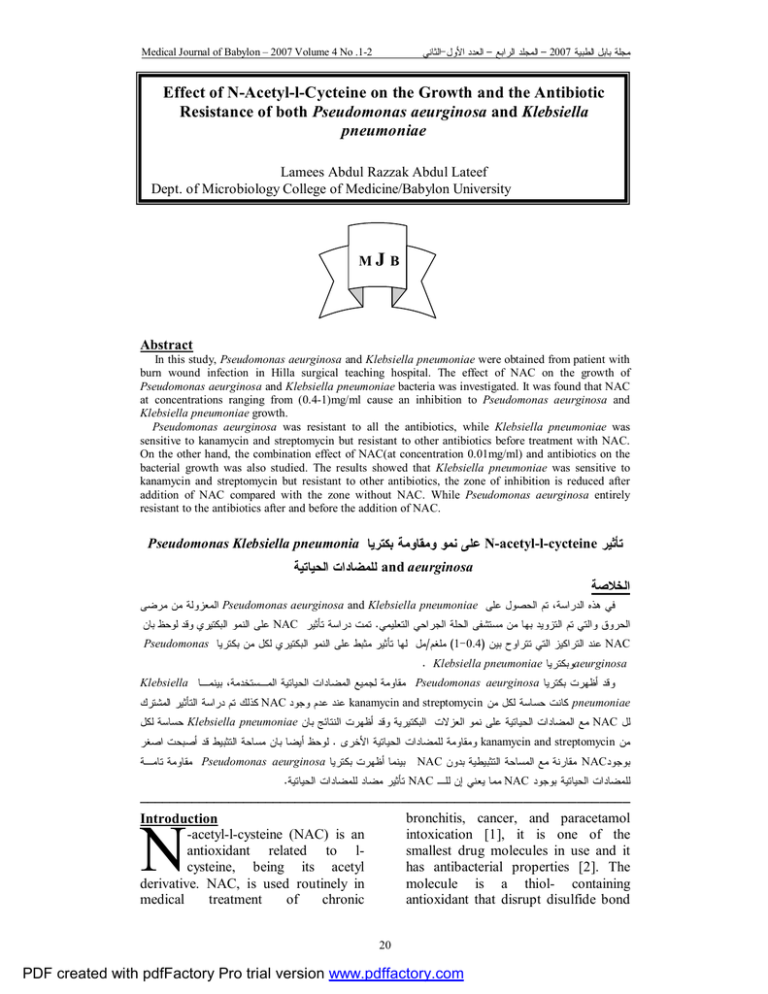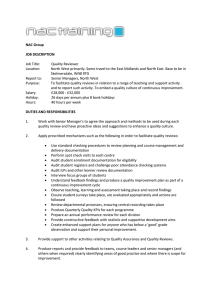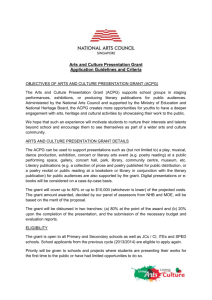Document 12454728
advertisement

ﺍﻟﺜﺎﻨﻲ- – ﺍﻟﻤﺠﻠﺩ ﺍﻟﺭﺍﺒﻊ – ﺍﻟﻌﺩﺩ ﺍﻷﻭل2007 ﻤﺠﻠﺔ ﺒﺎﺒل ﺍﻟﻁﺒﻴﺔ Medical Journal of Babylon – 2007 Volume 4 No .1-2 Effect of N-Acetyl-l-Cycteine on the Growth and the Antibiotic Resistance of both Pseudomonas aeurginosa and Klebsiella pneumoniae Lamees Abdul Razzak Abdul Lateef Dept. of Microbiology College of Medicine/Babylon University MJ B Abstract In this study, Pseudomonas aeurginosa and Klebsiella pneumoniae were obtained from patient with burn wound infection in Hilla surgical teaching hospital. The effect of NAC on the growth of Pseudomonas aeurginosa and Klebsiella pneumoniae bacteria was investigated. It was found that NAC at concentrations ranging from (0.4-1)mg/ml cause an inhibition to Pseudomonas aeurginosa and Klebsiella pneumoniae growth. Pseudomonas aeurginosa was resistant to all the antibiotics, while Klebsiella pneumoniae was sensitive to kanamycin and streptomycin but resistant to other antibiotics before treatment with NAC. On the other hand, the combination effect of NAC(at concentration 0.01mg/ml) and antibiotics on the bacterial growth was also studied. The results showed that Klebsiella pneumoniae was sensitive to kanamycin and streptomycin but resistant to other antibiotics, the zone of inhibition is reduced after addition of NAC compared with the zone without NAC. While Pseudomonas aeurginosa entirely resistant to the antibiotics after and before the addition of NAC. Pseudomonas Klebsiella pneumonia ﻋﻠﻰ ﻨﻤﻭ ﻭﻤﻘﺎﻭﻤﺔ ﺒﻜﺘﺭﻴﺎN-acetyl-l-cycteine ﺘﺄﺜﻴﺭ ﻟﻠﻤﻀﺎﺩﺍﺕ ﺍﻟﺤﻴﺎﺘﻴﺔand aeurginosa اﻟﺨﻼﺻﺔ ﺍﻟﻤﻌﺯﻭﻟﺔ ﻤﻥ ﻤﺭﻀﻰPseudomonas aeurginosa and Klebsiella pneumoniae ﺘﻡ ﺍﻟﺤﺼﻭل ﻋﻠﻰ،ﻓﻲ ﻫﺫﻩ ﺍﻟﺩﺭﺍﺴﺔ ﻋﻠﻰ ﺍﻟﻨﻤﻭ ﺍﻟﺒﻜﺘﻴﺭﻱ ﻭﻗﺩ ﻟﻭﺤﻅ ﺒﺎﻥNAC ﺘﻤﺕ ﺩﺭﺍﺴﺔ ﺘﺄﺜﻴﺭ.ﺍﻟﺤﺭﻭﻕ ﻭﺍﻟﺘﻲ ﺘﻡ ﺍﻟﺘﺯﻭﻴﺩ ﺒﻬﺎ ﻤﻥ ﻤﺴﺘﺸﻔﻰ ﺍﻟﺤﻠﺔ ﺍﻟﺠﺭﺍﺤﻲ ﺍﻟﺘﻌﻠﻴﻤﻲ Pseudomonas ﻤل ﻟﻬﺎ ﺘﺄﺜﻴﺭ ﻤﺜﺒﻁ ﻋﻠﻰ ﺍﻟﻨﻤﻭ ﺍﻟﺒﻜﺘﻴﺭﻱ ﻟﻜل ﻤﻥ ﺒﻜﺘﺭﻴﺎ/ ( ﻤﻠﻐﻡ1- 0.4) ﻋﻨﺩ ﺍﻟﺘﺭﺍﻜﻴﺯ ﺍﻟﺘﻲ ﺘﺘﺭﺍﻭﺡ ﺒﻴﻥNAC . Klebsiella pneumoniae ﻭﺒﻜﺘﺭﻴﺎaeurginosa Klebsiella ﺒﻴﻨﻤـﺎ، ﻤﻘﺎﻭﻤﺔ ﻟﺠﻤﻴﻊ ﺍﻟﻤﻀﺎﺩﺍﺕ ﺍﻟﺤﻴﺎﺘﻴﺔ ﺍﻟﻤـﺴﺘﺨﺩﻤﺔPseudomonas aeurginosa ﻭﻗﺩ ﺃﻅﻬﺭﺕ ﺒﻜﺘﺭﻴﺎ ﻜﺫﻟﻙ ﺘﻡ ﺩﺭﺍﺴﺔ ﺍﻟﺘﺄﺜﻴﺭ ﺍﻟﻤﺸﺘﺭﻙNAC ﻋﻨﺩ ﻋﺩﻡ ﻭﺠﻭﺩkanamycin and streptomycin ﻜﺎﻨﺕ ﺤﺴﺎﺴﺔ ﻟﻜل ﻤﻥpneumoniae ﺤﺴﺎﺴﺔ ﻟﻜلKlebsiella pneumoniae ﻤﻊ ﺍﻟﻤﻀﺎﺩﺍﺕ ﺍﻟﺤﻴﺎﺘﻴﺔ ﻋﻠﻰ ﻨﻤﻭ ﺍﻟﻌﺯﻻﺕ ﺍﻟﺒﻜﺘﻴﺭﻴﺔ ﻭﻗﺩ ﺃﻅﻬﺭﺕ ﺍﻟﻨﺘﺎﺌﺞ ﺒﺎﻥNAC ﻟل ﻟﻭﺤﻅ ﺃﻴﻀﺎ ﺒﺎﻥ ﻤﺴﺎﺤﺔ ﺍﻟﺘﺜﺒﻴﻁ ﻗﺩ ﺃﺼﺒﺤﺕ ﺍﺼﻐﺭ. ﻭﻤﻘﺎﻭﻤﺔ ﻟﻠﻤﻀﺎﺩﺍﺕ ﺍﻟﺤﻴﺎﺘﻴﺔ ﺍﻷﺨﺭﻯkanamycin and streptomycin ﻤﻥ ﻤﻘﺎﻭﻤﺔ ﺘﺎﻤـﺔPseudomonas aeurginosa ﺒﻴﻨﻤﺎ ﺃﻅﻬﺭﺕ ﺒﻜﺘﺭﻴﺎ NAC ﻤﻘﺎﺭﻨﺔ ﻤﻊ ﺍﻟﻤﺴﺎﺤﺔ ﺍﻟﺘﺜﺒﻴﻁﻴﺔ ﺒﺩﻭﻥNACﺒﻭﺠﻭﺩ . ﺘﺄﺜﻴﺭ ﻤﻀﺎﺩ ﻟﻠﻤﻀﺎﺩﺍﺕ ﺍﻟﺤﻴﺎﺘﻴﺔNAC ﻤﻤﺎ ﻴﻌﻨﻲ ﺇﻥ ﻟﻠـNAC ﻟﻠﻤﻀﺎﺩﺍﺕ ﺍﻟﺤﻴﺎﺘﻴﺔ ﺒﻭﺠﻭﺩ ـــــــــــــــــــــــــــــــــــــــــــــــــــــــــــــــــ bronchitis, cancer, and paracetamol intoxication [1], it is one of the smallest drug molecules in use and it has antibacterial properties [2]. The molecule is a thiol- containing antioxidant that disrupt disulfide bond Introduction -acetyl-l-cysteine (NAC) is an antioxidant related to lcysteine, being its acetyl derivative. NAC, is used routinely in medical treatment of chronic N 20 PDF created with pdfFactory Pro trial version www.pdffactory.com ﺍﻟﺜﺎﻨﻲ- – ﺍﻟﻤﺠﻠﺩ ﺍﻟﺭﺍﺒﻊ – ﺍﻟﻌﺩﺩ ﺍﻷﻭل2007 ﻤﺠﻠﺔ ﺒﺎﺒل ﺍﻟﻁﺒﻴﺔ Medical Journal of Babylon – 2007 Volume 4 No .1-2 concentration of (0.05, 0.1, 0.2, 0.4, 0.6, 0.8, 1) mg/ml respectively. 2- The plates were inoculated by bacterial isolates, then incubated for 24hr. at 37Cº. 3- After period of an incubation the results were read according the presence of growth or absent. 2- The Combination effect of some antibiotics with NAC on the growth of isolates:Muller Hinton agar is used to show the effect of the following antibiotics Kanamycin, Streptomycin, Gentamycin, Cefixime, Refamicin, and Ciprofloxacin in the presence of 0.01mg/ml of NAC. NAC is sterilized by filtration where as the media is sterilizing by autoclaving at 121Cº for 15min. After solidification of the media, the bacteria was inoculated and spreaded on the culture media and then the antibiotic discs were placed. in mucus [3, 4], and competitively (cysteine) utilization [5, 6]. Stagnaro, et.al suggests that NAC provides lymphocytic protection against toxic oxygen species[7]. The effect of NAC on bacteria and bacterial biofilms is still relatively unknown, and a better understanding of bacterial responses to NAC may facilitate efficient use of this compound as a biofilm inhibitor. NAC is able to inhibit growth of both gram positive and gram negative bacteria [8], also NAC decreases the production of extracellular polysaccharide of both gram positive and gram negative bacteria, when it is present in the culture media during growth [9]. This study is aimed to show the effect of NAC on bacterial growth and also its effect on antibiotic effect. Material and Methods This study was carried out in Hilla surgical teaching hospital. Pseudomonas aeurginosa and Klebsiella pneumoniae were obtained from patient with burn wound infection. 1- Effect of NAC on bacterial growth:The effect of NAC on bacterial growth was tested by the modified method which was mentioned by [10]:1- Nutrient agar was and added in Petri dish then NAC sterilized by filtration) was added to each plate at different volumes to obtain the final Results and Discussion NAC is used in medical treatment of patient with chronic bronchitis. The positive effects of NAC treatment have primarily been attributed to the mucusdissolving properties, as well as its ability to decrease biofilm formation which reduce bacterial infection [11]. In table (1), the bacteria used in this study were able to grow in the presence of low concentration of NAC (0.05-0.2)mg/ml, which is the same results obtained by [12]. NAC at concentrations above 0.4mg/ml was able to inhibition the growth of these bacteria. 21 PDF created with pdfFactory Pro trial version www.pdffactory.com ﺍﻟﺜﺎﻨﻲ- – ﺍﻟﻤﺠﻠﺩ ﺍﻟﺭﺍﺒﻊ – ﺍﻟﻌﺩﺩ ﺍﻷﻭل2007 ﻤﺠﻠﺔ ﺒﺎﺒل ﺍﻟﻁﺒﻴﺔ Medical Journal of Babylon – 2007 Volume 4 No .1-2 Table 1 Effect of NAC on bacterial growth Concentration Growth of Klebsiella of NAC mg/ml Pseudomonas aeurginosa pneumoniae 0.05 + + 0.1 + + 0.2 + + 0.4 0.6 0.8 1 (+) growth (-) no growth by virtue of possessing a sulfhydryl group, which may react with bacterial cell protein. Or, on the other hand, NAC is an antioxidant has indirect effect on cell metabolism and extracellular polysaccharide production [11]. Table (2), showed that Pseudomonas aeuroginosa was resistance to all the antibiotics without the addition of NAC. While, Klebsiella pneumoniae was sensitive to kanamycin and streptomycin but resistance to other antibiotics without addition of NAC. NAC, which is one of the most popular mucus liquefying agents, has appreciated in vitro activity against Pseudomonas aeurginosa [13] as being growth inhibition. In addition in the presence of NAC, Klebsiella pneumoniae was unable to form large colonies, only single and small colonies were present, which changed the texture of the biofilm form [14]. The effects of NAC on inoculum size is a dose dependent it was attributed to a competitively inhibition amino acid (cysteine) utilization [6], or Table 2 The Combination effect of NAC (at concentration 0.01mg/ml) and antibiotic on bacterial growth With NAC Without NAC Pseudomonas Klebsiella Antibiotics Pseudomonas Klebsiella aeurginosa pneumoniae aeurginoa pneumoniae Kanamycin + Streptomycin + Gentamicin + Cefixime + Refamicin + Ciprofloxacin + P value Less than 0.05 (+) Resistance (-) Sensitive *zone of inhibition≤15 **zone of inhibition>20 Also, this table showed that Klebsiella pneumoniae was sensitive to kanamycine and streptomycin but resistance to other antibiotics after the -** -** + + + + + + + + + + No signifhcant -* -* + + + + addition of NAC. It was shown previously that NAC diminishes the activity of aminocyclitol antibiotics, neomycin, streptomycin and 22 PDF created with pdfFactory Pro trial version www.pdffactory.com ﺍﻟﺜﺎﻨﻲ- – ﺍﻟﻤﺠﻠﺩ ﺍﻟﺭﺍﺒﻊ – ﺍﻟﻌﺩﺩ ﺍﻷﻭل2007 ﻤﺠﻠﺔ ﺒﺎﺒل ﺍﻟﻁﺒﻴﺔ Medical Journal of Babylon – 2007 Volume 4 No .1-2 7- Stagnaro, R., I. Pierri, P. Piovano, et.al., Bull Eur Physipathol. Respir., 1987, 23:303-307. 8- Parry, M.F. and H.C. Neu, J. Clin. Microbiol., 1977, 5:58-61. 9- Olofsson, A.C., A. Zita and M. Hermansson, Microbiology, 1998, 144:519-528. 10- AL-wash, B. Ms.C. Thesis. College of Medicine Babylon University, 2006. 11- Olofsson, A.C., M. Hermasson and H. Elwing, App. Environ. Microbiol., 2005, 71(5):2705-2712. 12- Olofsson, A.C., M. Hermasson and H. Elwing, App. Environ. Microbiol., 2003, 69(8):4814-4822. 13- Michael, F. and C. Harold, J. Clin. Microbiol., 1977, 5(1):58-61. 14- Costerton, J.W., Z. Lewandowski, D.E. Caldwell, D.R. Korber and H.M.Lappin-Scott, Annu. Rev. Microbiol., 1995, 49:711-745. 15- Gottschalk, V.B., and G. Wichmann, Dstch. Gesundheitswes, 1970, 25:700-702. 16- Saggers, B.A. and D. Lawson, J. Clin. Pathol., 1966, 19:313-317. 17- Perez-Giraldo,C., A. RodriguezBenito, F.J. Moran, C. Hurtado, M.T. Blanco and A.C. Gomez-Garcia, J. Antimicrob. Chemother., 1997, 39:643-646. 18- Lawson, D. and B.A. Saggers, Br. Med. J., 1965,1:317. kanamycin [15, 16]. It was found that the combination of streptomycin and kanamycin with NAC was antagonistic against Klebsiella pneumoniae. The inhibition zone is reduced after the addition of NAC. It was seen that Pseudomonas aeurginosa was not inhibited by the addition of NAC. NAC is considered to be a nonantibiotic drug but to have antibacterial (bacteriostatic) properties [17] when added to the media alone. It is an effective mucolytic agent having antagonistic effect to the activity to the several antibiotics [18]. References 1- Stey, C., J. Steurer, S. Bachmann, T.C. Medici and M.R. Tramer, Eur. Respir. J., 2000, 16:253-262. 2- Noszal, B., D. Visky and M. Kraszni, J. Med. Chem., 2000, 43:2176-2182. 3- Blanco, M.T., J. Blanco, R. Sanchez-Benito, C. Perez-Giraldo, F.J. Moran, C. Hurtado and A.C. GomesGarcia, Microbios, 1997,89:23-28. 4- Sheffner, A.L., Ann. NY. Acad. Sci., 1963, 106:298-310. 5- Ventura, P., R. Panini, M.C. Pasini, G. Scarpetta and G. Salvloli, Pharmacol. Res., 1999, 40:345-350. 6- Zygmunt, W.A. and T.A. Martin, J. Med. Chem., 1968, 11:623-625. 23 PDF created with pdfFactory Pro trial version www.pdffactory.com

